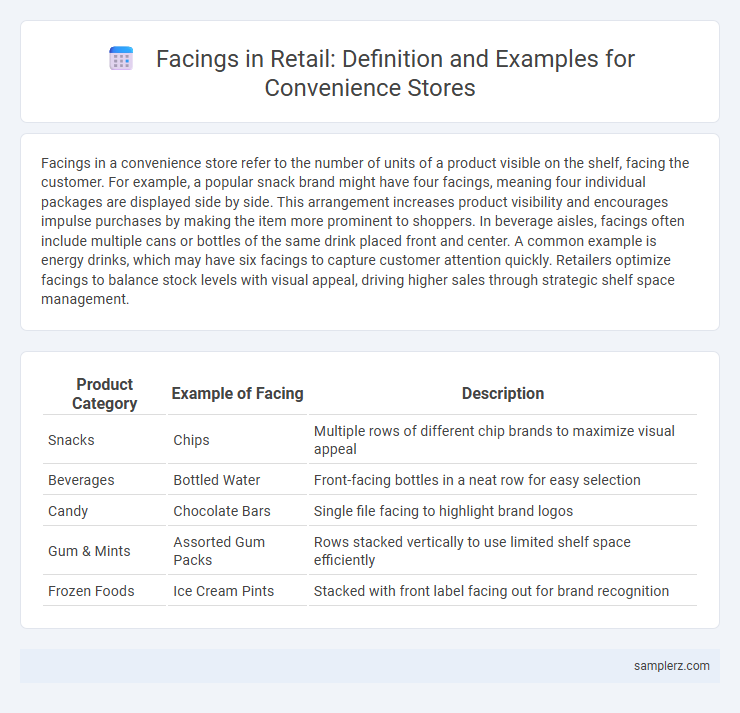Facings in a convenience store refer to the number of units of a product visible on the shelf, facing the customer. For example, a popular snack brand might have four facings, meaning four individual packages are displayed side by side. This arrangement increases product visibility and encourages impulse purchases by making the item more prominent to shoppers. In beverage aisles, facings often include multiple cans or bottles of the same drink placed front and center. A common example is energy drinks, which may have six facings to capture customer attention quickly. Retailers optimize facings to balance stock levels with visual appeal, driving higher sales through strategic shelf space management.
Table of Comparison
| Product Category | Example of Facing | Description |
|---|---|---|
| Snacks | Chips | Multiple rows of different chip brands to maximize visual appeal |
| Beverages | Bottled Water | Front-facing bottles in a neat row for easy selection |
| Candy | Chocolate Bars | Single file facing to highlight brand logos |
| Gum & Mints | Assorted Gum Packs | Rows stacked vertically to use limited shelf space efficiently |
| Frozen Foods | Ice Cream Pints | Stacked with front label facing out for brand recognition |
Importance of Product Facings in Convenience Stores
Product facings in convenience stores directly influence consumer purchase decisions by enhancing product visibility and accessibility on shelves. Optimizing facings for high-demand items, such as beverages and snacks, increases sales velocity and inventory turnover rates. Strategic facings also create an organized shopping experience, encouraging impulse buys and reinforcing brand recognition.
Beverage Section: Maximizing Facings for Soft Drinks
Maximizing facings for soft drinks in the beverage section of a convenience store involves strategically placing popular brands like Coca-Cola, Pepsi, and Red Bull to enhance visibility and increase sales. Allocating multiple facings to best-selling items such as regular and diet sodas, energy drinks, and flavored waters ensures quick customer access and encourages brand loyalty. Optimized shelf space and facings enable retailers to showcase product variety while driving higher turnover and improving overall beverage category performance.
Snack Shelf Arrangement and Facing Examples
Snack shelf arrangement in convenience stores typically involves organizing products by category, brand, and flavor to maximize visibility and accessibility. Popular facing examples include grouping chips and pretzels together with at least three to four facings per SKU, placing candy bars with prominent branding at eye level, and aligning healthier snack options on lower shelves to target different customer preferences. Strategic facings increase product exposure, encourage impulse purchases, and optimize space utilization within the limited retail footprint.
Dairy Products: Effective Facing Strategies
Dairy products in convenience stores are typically faced with yogurt, milk cartons, and cheese varieties neatly aligned at eye level to maximize visibility and accessibility. Effective facing strategies include grouping similar dairy items, such as flavored yogurts or low-fat milk, to encourage comparison and quick decision-making by consumers. Strategic placement near checkout aisles also boosts impulse purchases of high-margin dairy snacks like string cheese and single-serve creamers.
Impulse Purchase Zones: Candy and Gum Facings
Candy and gum facings in convenience stores are strategically placed near checkout counters to maximize impulse purchases. These products are stocked in high-visibility, easy-to-grab displays that attract attention during wait times. Properly managed facings increase sales by encouraging last-minute additions to customers' baskets.
Fresh Foods Display: Sandwich and Salad Facings
Sandwich and salad facings in convenience store fresh foods displays are strategically arranged to maximize visibility and accessibility, with sandwiches typically positioned at eye level to encourage impulse purchases. Salads are often displayed in clear, refrigerated cases with vibrant packaging that highlights freshness and variety, enhancing customer appeal. Optimizing these facings increases turnover rates by showcasing product quality and convenience, directly impacting sales performance.
Health and Beauty Aisle Facings
Health and Beauty aisle facings in convenience stores typically include prominent placements of skincare products, over-the-counter medications, and personal hygiene items such as toothpaste and deodorants. High-demand brands like Neutrogena, Colgate, and Dove are often positioned at eye level to maximize customer visibility and boost impulse purchases. Strategic shelf organization, featuring seasonal promotions and travel-sized products, enhances shopper convenience and drives sales in this competitive retail segment.
Seasonal Products: Adjusting Facings for Promotions
Seasonal products in convenience stores, such as holiday-themed snacks and summer beverages, require strategic facings to maximize visibility and sales during peak promotion periods. Increasing the number of facings for these items in high-traffic aisles and near checkout counters enhances impulse purchases and aligns inventory with current demand. Regularly updating facings based on seasonal trends and sales data ensures optimal product turnover and customer engagement.
Differences in Private Label vs. National Brand Facings
Private label facings in convenience stores often occupy less shelf space but target specific consumer needs with strategic placement near checkout areas, emphasizing value pricing. National brand facings typically dominate prime shelf areas with higher facings and prominent eye-level positioning to leverage brand recognition and drive impulse purchases. This difference in facings reflects varying retailer priorities in balancing cost-efficiency and maximizing consumer appeal.
Optimizing Shelf Space: Best Practices for Facings
Maximizing facings in convenience stores enhances product visibility and drives sales by organizing items by category and popularity. Implementing vertical facings for high-demand products and horizontal facings for complementary items effectively utilizes limited shelf space. Strategic placement near checkout areas and eye-level shelves increases customer engagement, boosting impulse purchases and overall store profitability.

example of facings in convenience store Infographic
 samplerz.com
samplerz.com